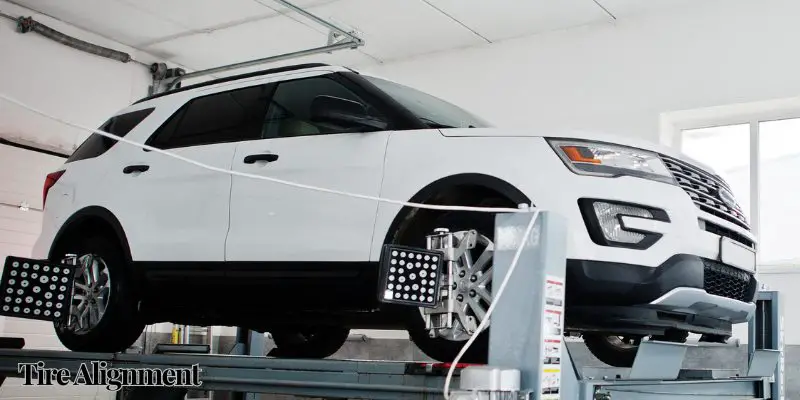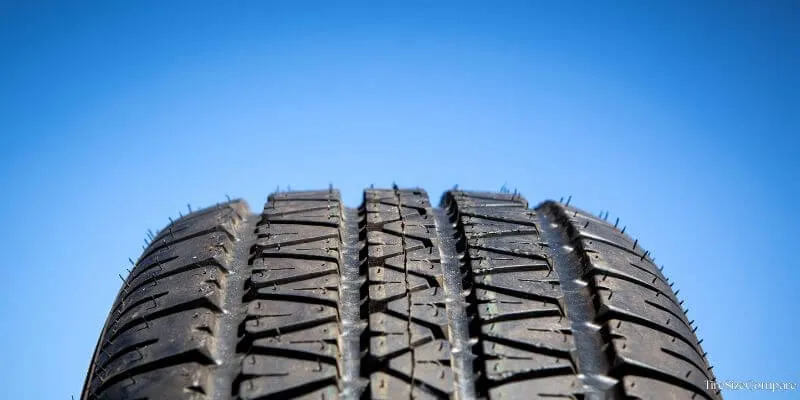Tire Alignment Guide

Tire alignment, also known as wheel alignment, is the process of adjusting the angles of your vehicle’s wheels so they are set to the manufacturer’s specifications.
Proper alignment ensures your car drives straight and smoothly, reduces tire wear, and improves fuel efficiency. Misaligned tires can cause uneven wear, poor handling, and decreased gas mileage.
What Is Tire Alignment?
When we talk about tire alignment, we’re really discussing the adjustment of your car’s suspension system. This system is like the skeleton of your vehicle, connecting the body to the wheels. Alignment involves adjusting the angles of the tires to ensure they’re positioned correctly relative to the road and each other.
Imagine you’re riding a bicycle with the handlebars slightly turned. You’d have to constantly correct your course to ride straight. That’s similar to what happens when your car’s alignment is off – it wants to pull to one side, making driving less efficient and more tiring.
Signs You Need an Alignment
Your car can’t speak, but it has ways of telling you when it needs an alignment. Here are some signs to watch for:
- Uneven tire wear: If one side of your tire is wearing faster than the other, it’s a clear sign of misalignment.
- Pulling to one side: Your car should drive straight on a level road. If it constantly drifts left or right, it’s time for an alignment check.
- Off-center steering wheel: When driving straight, your steering wheel should be centered. If it’s tilted, your alignment might be off.
- Steering wheel vibration: Excessive vibration while driving can indicate alignment issues.
- Squealing tires: Misaligned tires can sometimes make a squealing noise, especially when turning.

The Three Key Angles of Alignment
When mechanics talk about alignment, they focus on three main angles:
- Camber: This is the inward or outward tilt of the tire when viewed from the front. Too much tilt either way can cause uneven wear.
- Toe: Imagine looking at your tires from above. Toe alignment refers to whether they point slightly inward or outward. Proper toe alignment ensures your tires roll straight.
- Caster: This angle affects your steering and stability. It’s the forward or backward slope of the steering axis when viewed from the side.
Why Alignment Matters
Proper alignment isn’t just about a smooth ride – it affects your car’s performance in several ways:
- Tire longevity: Misaligned wheels can cause your tires to wear unevenly and prematurely. Good alignment helps your tires last longer, saving you money.
- Fuel efficiency: When your wheels are properly aligned, your car doesn’t have to work as hard to move forward, which can improve fuel economy.
- Safety: Correct alignment improves handling and reduces the risk of your car pulling to one side, especially during emergency maneuvers.
- Comfort: A well-aligned car provides a smoother, more comfortable ride with less vibration and noise.

The Alignment Process
Getting your wheels aligned is a job for the professionals. Here’s what typically happens:
- The mechanic places your car on a special alignment rack.
- Sensors are attached to each wheel to measure the current alignment angles.
- These measurements are compared to the manufacturer’s specifications for your specific vehicle model.
- The mechanic adjusts the suspension components as needed to bring the alignment back to spec.
- A road test is often performed to ensure everything feels right.
Alignment vs. Balancing
People often confuse alignment with tire balancing, but they’re different services:
- Alignment adjusts the angles of the wheels to ensure they’re positioned correctly.
- Balancing ensures the weight is evenly distributed around each tire and wheel assembly.
Both services are important for a smooth ride and even tire wear, but they address different issues.
When to Get an Alignment
Most experts recommend getting your alignment checked every 12,000 to 15,000 miles or at least once a year. However, you should also get an alignment:
- After hitting a major pothole or curb
- When you get new tires installed
- If you notice any of the signs mentioned earlier
DIY Alignment Checks
While you can’t align your wheels at home, you can perform some basic checks:
- Park on a flat surface and check if your steering wheel is centered when the wheels are straight.
- Drive on a straight, level road (with no one behind you) and see if your car pulls to one side when you briefly let go of the wheel.
- Visually inspect your tires for uneven wear patterns.
If you notice any issues, it’s time to visit a professional for an alignment check.
How Much Does a Tire Alignment Cost?
The cost can vary, but typically ranges from $50 to $200, depending on your vehicle and location.
How Long Does an Alignment Take?
A standard alignment usually takes about an hour, but it can take longer if significant adjustments are needed.
Can I Drive With Bad Alignment?
While you can, it’s not recommended. Bad alignment can lead to rapid tire wear and potential safety issues.
Do All Cars Need Four-Wheel Alignment?
Not all. Some vehicles only need front-wheel alignment, while others require all four wheels to be aligned.
Will New Tires Fix Alignment Issues?
No, new tires won’t fix alignment problems. In fact, driving on new tires with bad alignment will cause them to wear out faster.
Conclusion
Proper tire alignment is crucial for safe and efficient driving. It ensures your vehicle handles well, extends the life of your tires, and improves fuel efficiency.
Regular alignment checks and maintenance can prevent issues and keep your car running smoothly. If you notice any signs of misalignment, it’s important to have your alignment checked by a professional to maintain the safety and performance of your vehicle.



